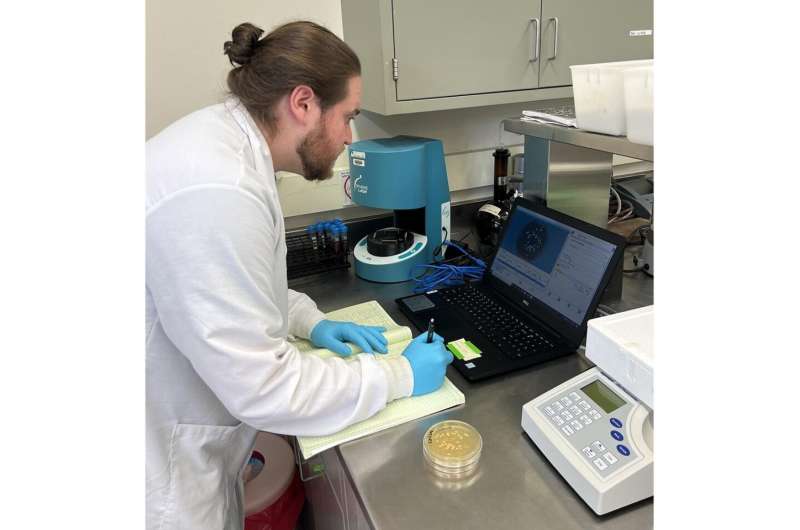This article has been reviewed according to Science X's editorial process and policies. Editors have highlighted the following attributes while ensuring the content's credibility:
fact-checked
peer-reviewed publication
trusted source
proofread
Researchers develop model to guide milk processors' food safety decisions

Certain strains of bacteria can withstand heat treatments such as pasteurization of milk and possess the potential to induce foodborne illness. To help minimize and predict the magnitude of this risk, a team led by Penn State researchers has developed a model that can guide processors to improve food safety.
In findings published this week in the Journal of Dairy Science, the researchers described their model that assesses high-temperature, short-time pasteurized milk—the most common method of pasteurization in the United States today—and how it might expose consumers to pathogenic Bacillus cereus group organisms, which include eight species of bacteria.
"The Bacillus cereus group is a diverse group of microorganisms in terms of their implications on food spoilage and safety," said team leader Jasna Kovac, Lester Earl and Veronica Casida Career Development Professor of Food Safety in the College of Agricultural Sciences at Penn State.
"The novelty of our study is in generating experimental growth data and models for different genotypes, or genetic makeups, of toxin-producing B. cereus group strains. Our approach to elucidate differences in the growth potential of various genotypes in milk allowed us to develop a more accurate exposure-assessment model."
The model can inform food safety decision-making in industries that test milk, according to Kovac. Processors test the milk to determine which strains of Bacillus cereus group bacteria and how much may contaminate the product. They can feed that information into the model to predict whether a contaminant will likely grow to a high level in a large proportion of produced food units, resulting in high-risk exposure for many customers.
Foods contaminated with 100,000 cells per milliliter of Bacillus cereus group microorganisms have been linked to foodborne illness, Kovac noted. In the model developed in this study, some genotypes were predicted to grow to 100,000 cells per milliliter of milk, but the concentration per simulated milk container could vary from very low levels of bacteria to 10 times more.
"This is significant because this difference in exposure can be translated to different levels of risk for foodborne illness," she said.
In the study, researchers measured the growth, in skim milk, of 17 toxin-producing Bacillus cereus strains across the gene profiles of six related bacteria groups with various virulence, or ability to cause disease. The strains did not grow in high-temperature, short-time pasteurized milk at 39 degrees Fahrenheit or 43 F; at 46 F, one strain grew; at 50 F, 15 strains grew; and all strains grew at temperatures of 57 F or above.
Using this growth data, the researchers developed secondary growth models and the exposure-assessment model. This model, focusing on the high-temperature, short-time pasteurized milk supply chain and up to 35 days of consumer storage, with an initial contamination of 100 cells per milliliter, estimated that 2.8% of milk containers would surpass potentially dangerous levels of Bacillus cereus group bacteria by day 21 and 4.1% would by day 35.
"I believe that this tool can provide a valuable decision-support system for dairy companies, particularly if food safety systems continue to move toward a truly risk-based approach that accepts that zero risk is not possible," said Martin Wiedmann, research team member and professor of food safety and food science at Cornell University. "In addition, I believe that other food industry sectors may adapt this tool to provide decision-making support in other types of food products."
The next step in the research is aimed at making this new technology accessible to the dairy industry. Kovac explained that the researchers are now working on integrating this model into an open-access application that will be available for milk processors to use to inform their food safety decision-making.
"We are working on a system in which a user can enter the concentration of bacteria detected in milk and upload the information about the genotype," said Jun Su, co-first author of this study, who is a doctoral student in food science working in Wiedmann's research group at Cornell. "That will produce a prediction of what percentage of milk containers likely will carry B. cereus exceeding the concentration that has previously been linked to foodborne illness."
That prediction is based on results generated by this research, according to Tyler Chandross-Cohen, co-first author of the study, who is a doctoral candidate in food science working in Kovac's research group at Penn State.
"Our data quantifies the ability of different genotypes of Bacillus cereus group bacteria to grow at various temperatures, as well as their ability to produce toxins that make people sick," he said.
More information: Jun Su et al, Assessment of the exposure to cytotoxic Bacillus cereus group genotypes through HTST milk consumption, Journal of Dairy Science (2024). DOI: 10.3168/jds.2024-24703
Journal information: Journal of Dairy Science
Provided by Pennsylvania State University





















